Development of Generalized Distribution Utility Index in Consumer-Driven Logistics
Abstract
:1. Introduction
- (1)
- Analysis of the literature in two aspects: assessment of the efficiency of goods supply in urban goods distribution and assessment of shopping mobility costs of end-consumers;
- (2)
- Formation of the goal and hypothesis;
- (3)
- Generalized distribution costs in consumer-driven logistics concept;
- (4)
- Modeling results, which consist of the formation of initial data and the definition of constraints, simulation scenario of distribution, patterns of change in the consumption value of end-consumers when consuming goods, patterns changing the parameters of the delivery of freight flows in urban transport systems;
- (5)
- Discussion and conclusions.
2. Materials and Methods
2.1. Evaluation of the Goods Supply Efficiency
2.2. Assessment of Consumption Efficiency for End-Consumers
3. Results
3.1. Generalized Distribution Utility Index in Consumer-Driven Logistics Concept
- (1)
- Definition of service areas and their parameters include: (a) an individual consumption rate of residents; (b) population density in residential areas; (c) socio-economic factors; (d) analysis of the road network. These data assess end-consumers’ behavior and constraints of the system in the current zone, as well as economic development, goals, and objectives, establishing links between parts.
- (2)
- Determining the demand and sales includes: (a) distribution of demand among retailers (competitor analysis (determination of market share) and determination of demand parameters); (b) transport flows; (c) e-commerce; (d) pedestrian flows.
- (3)
- Determination of the volume of goods delivery. Estimation of amount of goods to deliver including demand and stocks, selection resources and constraints.
- (4)
- Development of schemes for the promotion of goods includes: (a) defining a system of constraints and assumptions for individual zones; (b) determination of all participants in the product promotion scheme and the links between them; (c) determination of product promotion schemes
- (5)
- Design of the technological process of the functioning of the goods promotion scheme includes: (a) determining the parameters of the warehouse subsystem; (b) determining the parameters of goods suppliers; (c) determining the parameters of the system of sales of goods and services (shops); (d) determining the parameters of the transport subsystem.
- (6)
- Calculation of efficiency indicators includes estimation of the profit-related distribution scenario of goods and costs related to shopping activity, as well as the calculation of mathematical and logical models that reflect the system of connections between goals, alternative means of achieving them, and the external environment.
- (7)
- Estimation of the generalized distribution utility index. Generalized utility index of distribution scenario estimation for each possible option. Calculation of the criterion for choosing the best option that allows to compare the goals and benefits of the consumer-driven logistics.
- (8)
- Selection of the option with highest generalized utility index of distribution scenario to assess maximum possible options among all possible. A holistic optimization of all the parts of the consumer-driven logistics is made.
- (9)
- Estimation of sustainable distribution scenario in consumer-driven logistics in the current situation.
3.2. Simulation Scenario of Supply
3.3. Regularities of Change in the Value Expression of the Consumption of End-Consumers When Consuming Goods
3.4. Patterns of Changing the Parameters of the Supply of Freight Flows in Urban Transport Systems
4. Discussion and Conclusions
Author Contributions
Funding
Institutional Review Board Statement
Informed Consent Statement
Data Availability Statement
Conflicts of Interest
References
- Sharma, P.; Chen, I.S.; Luk, S.T. Tourist shoppers’ evaluation of retail service: A study of cross-border versus international outshoppers. J. Hosp. Tour. Res. 2018, 42, 392–419. [Google Scholar] [CrossRef] [Green Version]
- Zatonatska, T.; Dluhopolskyi, O.; Chyrak, I.; Kotys, N. The internet and e-commerce diffusion in European countries (modeling at the example of Austria, Poland and Ukraine). Innov. Mark. 2019, 15, 66–75. [Google Scholar] [CrossRef] [Green Version]
- Beckers, J.R. The logistics sector in a consumer driven society, essays on location and network structure. In The Department of Transport and Regional Economics; The University of Antwerp: Antwerp, Belgium, 2019. [Google Scholar]
- Bolesnikov, M.; Stijačić, M.P.; Radišić, M.; Takači, A.; Borocki, J.; Bolesnikov, D.; Bajdor, P.; Dzieńdziora, J. Development of a business model by introducing sustainable and tailor-made value proposition for SME clients. Sustainability 2019, 11, 1157. [Google Scholar] [CrossRef] [Green Version]
- Russo, F.; Comi, A. Urban freight transport planning towards green goals: Synthetic environmental evidence from tested results. Sustainability 2016, 8, 381. [Google Scholar] [CrossRef] [Green Version]
- Comi, A.; Buttarazzi, B.; Schiraldi, M.M.; Innarella, R.; Varisco, M.; Rosati, L. DynaLOAD: A simulation framework for planning, managing and controlling urban delivery bays. Transp. Res. Procedia 2017, 22, 335–344. [Google Scholar] [CrossRef] [Green Version]
- Olkhova, M.; Roslavtsev, D.; Galkin, A. The Comparative Method of Assessing City Logistics Measure. In Decision Support Methods in Modern Transportation Systems and Networks; Springer: Cham, Switzerland, 2021; pp. 163–174. [Google Scholar]
- Greene, D.L.; Fan, Y.H. Transportation energy intensity trends: 1972–1992. Transp. Res. Rec. 1995, 1475. [Google Scholar]
- Cao, X.; OuYang, S.; Liu, D.; Yang, W. Spatiotemporal Patterns and Decomposition Analysis of CO2 Emissions from Transportation in the Pearl River Delta. Energies 2019, 12, 2171. [Google Scholar] [CrossRef] [Green Version]
- Van der Wardt, T.J.; Farid, A.M. A hybrid dynamic system assessment methodology for multi-modal transportation-electrification. Energies 2017, 10, 653. [Google Scholar] [CrossRef] [Green Version]
- Kush, Y.; Tonkoshkur, M.; Vakulenko, K.; Davidich, N.; Galkin, A. The rational scope of using direct and multilevel logistics channels for material flow distribution (case study in Ukraine). Indep. J. Manag. Prod. 2020, 11, 2805–2826. [Google Scholar] [CrossRef]
- Galkin, A.; Davidich, N.; Melenchuk, T.; Kush, Y.; Davidich, Y.; Lobashov, O. Modelling truck’s transportation speed on the route considering driver’s state. Transp. Res. Procedia 2018, 30, 207–215. [Google Scholar] [CrossRef]
- Davidich, Y.; Kush, Y.; Galkin, A.; Davidich, N.; Tkachenko, I. Improving of urban public transportation quality via operator schedule optimization. J. Urban Environ. Eng. 2019, 13, 23–33. [Google Scholar]
- Halkin, A.; Skrypin, V.; Kush, E.; Vakulenko, K.; Dolia, V. Invest approach to the transportation services cost formation. Procedia Eng. 2017, 178, 435–442. [Google Scholar] [CrossRef]
- Makarova, I.; Khabibullin, R.; Belyaev, E.; Mavrin, V. Increase of city transport system management efficiency with application of modeling methods and data intellectual analysis. In Intelligent Transportation Systems–Problems and Perspectives; Springer: Cham, Switzerland, 2016; pp. 37–80. [Google Scholar] [CrossRef]
- Bernardini, A.; Heemeryck, A.; Van Hoeck, E.; van Lier, T.; Macharis, C. Evaluating Climate Impacts of the Aviation Sector: A MCA-Analysis. In Proceedings of the European Transport Conference, Association for European Transport (AET), Lisbon, Portugal, 11–14 July 2010. [Google Scholar]
- Macharis, C. Multi-criteria analysis as a tool to include stakeholders in project evaluation: The MAMCA method. In Transport Project Evaluation. Extending the Social Cost–Benefit Approach; Edward Elgar Publishing: Cheltenham, UK, 2007; pp. 115–131. [Google Scholar]
- Fredriksson, A.; Janné, M.; Nolz, P.; de Chennevière, P.D.R.; van Lier, T.; Macharis, C. Creating stakeholder awareness in construction logistics by means of the MAMCA. City Environ. Interact 2021, 11, 100067. [Google Scholar] [CrossRef]
- Nathanail, E.; Karakikes, I.; Mitropoulos, L.; Adamos, G. A sustainability cross-case assessment of city logistics solutions. Case Stud. Transp. Policy 2021, 9, 219–240. [Google Scholar] [CrossRef]
- Ojala, L.; Celebi, D. The World Bank’s Logistics Performance Index (LPI) and drivers of logistics performance. In Proceedings of MAC-EMM, OECD; International Transport Forum: Paris, France, 2015. [Google Scholar]
- Kumar, A.; Anbanandam, R. Development of social sustainability index for freight transportation system. J. Clean. Prod. 2019, 210, 77–92. [Google Scholar] [CrossRef]
- De Oliveira, L.K.; de Araújo, G.G.F.; de Oliveira, I.K. How to explain the location of logistics warehouses from the urban quality-of-life index and the local supply index? WSB J. Bus. Financ. 2019, 53, 15–21. [Google Scholar] [CrossRef] [Green Version]
- Mahdinia, I.; Habibian, M.; Hatamzadeh, Y.; Gudmundsson, H. An indicator-based algorithm to measure transportation sustainability: A case study of the US states. Ecol. Indic. 2018, 89, 738–754. [Google Scholar] [CrossRef]
- Comi, A.; Persia, L.; Polimeni, A.; Campagna, A.; Mezzavilla, L. A methodology to design and assess scenarios within SULPS: The case of Bologna. Transp. Res. Procedia 2020, 46, 269–276. [Google Scholar] [CrossRef]
- Iwan, S.; Nürnberg, M.; Jedliński, M.; Kijewska, K. Efficiency of light electric vehicles in last mile deliveries–Szczecin case study. Sustain. Cities Soc. 2021, 74, 103167. [Google Scholar] [CrossRef]
- Wątróbski, J.; Małecki, K.; Kijewska, K.; Iwan, S.; Karczmarczyk, A.; Thompson, R.G. Multi-criteria analysis of electric vans for city logistics. Sustainability 2017, 9, 1453. [Google Scholar] [CrossRef] [Green Version]
- Comi, A.; Buttarazzi, B.; Schiraldi, M.; Innarella, R.; Varisco, M.; Traini, P. An advanced planner for urban freight delivering. Arch. Transp. 2018, 48, 27–40. [Google Scholar] [CrossRef]
- Kraus, L.; Proff, H. Sustainable Urban Transportation Criteria and Measurement—A Systematic Literature Review. Sustainability 2021, 13, 7113. [Google Scholar] [CrossRef]
- Halkin, A. Assessing the utility of retailer based on generalized costs of end-consumers. Found. Manag. 2020, 12, 31–42. [Google Scholar] [CrossRef] [Green Version]
- Galkin, A.; Mykola, K.; Balandina, I.; Anton, R.; Litomin, I.; Davidich, N.; Kumar, C. Assessing the impact of population mobility on consumer expenditures while shopping. Transp. Res. Procedia 2020, 48, 2187–2196. [Google Scholar] [CrossRef]
- Vignali, S.; Renko, S.; Dabrowska, A. Consumer behaviour in the market of catering services in selected countries of central–eastern Europe. Br. Food J. 2011, 1, 96–108. [Google Scholar]
- Santamaria, C.; Sermi, F.; Spyratos, S.; Iacus, S.M.; Annunziato, A.; Tarchi, D.; Vespe, M. Measuring the impact of COVID-19 confinement measures on human mobility using mobile positioning data. A European regional analysis. Saf. Sci. 2020, 132, 104925. [Google Scholar] [CrossRef] [PubMed]
- Borghesi, A. City Logistics: Is Deregulation the Answer? In Financial Environment and Business Development; Springer International Publishing: Cham, Switzerland, 2017; pp. 385–400. [Google Scholar]
- Lowson, B.; King, R.; Hunter, A. Quick Response: Managing the Supply Chain to Meet Consumer Demand; Wiley: Hoboken, NJ, USA, 1999. [Google Scholar]
- Lamming, R. Squaring lean supply with supply chain management. Int. J. Oper. Prod. Manag. 1996, 16, 183–196. [Google Scholar] [CrossRef]
- Reyes, P.M.; Bhutta, K. Efficient consumer response: Literature review. Int. J. Integr. Supply Manag. 2005, 1, 346–386. [Google Scholar] [CrossRef] [Green Version]
- Bookbinder, J.H.; Gümüş, M.; Jewkes, E.M. Calculating the benefits of vendor managed inventory in a manufacturer-retailer system. Int. J. Prod. Res. 2010, 48, 5549–5571. [Google Scholar] [CrossRef]
- Bajdor, P. Comparison between sustainable development concept and Green Logistics: The literature review. Pol. J. Manag. Stud. 2012, 5, 225–233. [Google Scholar]
- Gasser, R.G. Outsourcing Strategies in Manufacturing. Outsourcing Proj. 2002, 1, 450. [Google Scholar]
- Cardenas, I.; Borbon-Galvez, Y.; Verlinden, T.; Van de Voorde, E.; Vanelslander, T.; Dewulf, W. City logistics, urban goods distribution and last mile delivery and collection. Compet. Regul. Netw. Ind. 2017, 18, 22–43. [Google Scholar] [CrossRef]
- Starostka-Patyk, M. The use of information systems to support the management of reverse logistics processes. Procedia Comput. Sci. 2021, 192, 2586–2595. [Google Scholar] [CrossRef]
- Makarova, I.; Shubenkova, K.; Pashkevich, A.; Shepelev, V. The role of reverse logistics in the transition to a circular economy. In Proceedings of the International Conference on Reliability and Statistics in Transportation and Communication, Riga, Latvia, 17–20 October 2018; Springer: Cham, Switzerland, 2018; pp. 363–373. [Google Scholar]
- De Andres Gonzalez, O.; Koivisto, H.; Mustonen, J.M.; Keinänen-Toivola, M.M. Digitalization in Just-In-Time Approach as a Sustainable Solution for Maritime Logistics in the Baltic Sea Region. Sustainability 2021, 13, 1173. [Google Scholar] [CrossRef]
- Bvuchete, M.; Grobbelaar, S.S.; van Eeden, J. A Network Maturity Mapping Tool for Demand-Driven Supply Chain Management: A Case for the Public Healthcare Sector. Sustainability 2021, 13, 1988. [Google Scholar] [CrossRef]
- Lambrechts, W.; Son-Turan, S.; Reis, L.; Semeijn, J. Lean, green and clean? Sustainability reporting in the logistics sector. Logistics 2019, 3, 3. [Google Scholar] [CrossRef] [Green Version]
- Muilerman, G.J. Time-Based Logistics: An Analysis of the Relevance, Causes and Impacts. Ph.D. Thesis, Delft University of Technology, Delft, The Netherlands, 2001. [Google Scholar]
- Kijewska, K.; Jedliński, M.; Iwan, S. Ecological utility of FQP projects in the stakeholders’ opinion in the light of empirical studies based on the example of the city of Szczecin. Sustain. Cities Soc. 2021, 74, 103171. [Google Scholar] [CrossRef]
- Beckers, J.; Cárdenas, I.; Verhetsel, A. Identifying the geography of online shopping adoption in Belgium. J. Retail. Consum. Serv. 2018, 45, 33–41. [Google Scholar] [CrossRef]
- Rajagopalan, K.K. Global trends in supply chain management. ZENITH Int. J. Bus. Econ. Manag. Res. 2016, 6, 99–112. [Google Scholar]
- Centobelli, P.; Cerchione, R.; Esposito, E. Environmental Sustainability and Energy-Efficient Supply Chain Management: A Review of Research Trends and Proposed Guidelines. Energies 2018, 11, 275. [Google Scholar] [CrossRef] [Green Version]
- Huff, D.L. A Probabilistic Analysis of Shopping Center Trade Areas. Land Econ. 1963, 39, 81–90. [Google Scholar] [CrossRef]
- Applebaum, W. Can Store Location Be A Science ? Econ. Geogr. 1965, 41, 234–237. [Google Scholar] [CrossRef]
- Nakanishi, M.; Cooper, L.G. Parameter estimation for a multiplicative competitive interaction model: Least squares approach. J. Mark. Res. 1974, 303–311. [Google Scholar]
- Fotheringham, A.S. Some theoretical aspects of destination choice and their relevance to production-constrained gravity models. Environ. Plan. A 1983, 15, 1121–1132. [Google Scholar] [CrossRef]
- McFadden, D. The measurement of urban travel demand. J. Public Econ. 1974, 3, 303–328. [Google Scholar] [CrossRef]
- Rust, R.T.; Donthu, N. Capturing geographically localized misspecification error in retail store choice models. J. Mark. Res. 1995, 32, 103–110. [Google Scholar] [CrossRef] [Green Version]
- Kniazieva, T.V.; Shevchenko, A.V.; Inshin, M.I.; Yakovlyev, O.A. Current trends in the formation and development of insurance marketing in Ukraine. Risk Manag. Insur. Rev. 2021, 24, 279–292. [Google Scholar] [CrossRef]
- Ewing, B.T.; Barron, J.M.; Lynch, G.J. Understanding Macroeconomic Theory; Routledge: London, UK, 2006. [Google Scholar]
- Russo, F.; Comi, A. The simulation of shopping trips at urban scale: Attraction macro-model. Procedia Soc. Behav. Sci. 2012, 39, 387–399. [Google Scholar] [CrossRef]
- Jorgensen, D.L. Participant Observation: A Methodology for Human Studies; Sage Publications: London, UK, 1989. [Google Scholar]
- Halkin, A. Emotional state of consumer in the urban purchase: Processing data. Found. Manag. 2018, 10, 99–112. [Google Scholar] [CrossRef] [Green Version]
- Galkin, A.; Popova, Y.; Bodnaruk, O.; Zaika, Y.; Chuprina, E.; Shapovalenko, D.; Kolonataievskyi, O. Attractiveness modeling of retail on emotional fatigue of consumers. South East Eur. J. Econ. Bus. 2019, 14, 106–116. [Google Scholar]
- Galkin, A.; Zaytsev, V.; Shyshkin, V.; Obolentseva, L.; Popova, Y. Patterns of the Distribution of the Demand of End-Consumers among Retailers in the Zone of their Residence. Found. Manag. 2021, 13, 145–158. [Google Scholar] [CrossRef]
- Efremov, I.S.; Kobozev, V.M.; Yudin, V.A. Teoriya Gorodskih Passazhirskih Perevozok; Vysshaya Shkola: Moscow, Russia, 1980; p. 535. [Google Scholar]
- Sheffi, Y. Urban Transportation Networks; Prentice-Hall: Englewood Cliffs, NJ, USA, 1985; Volume 6. [Google Scholar]
- Cascetta, E.; Papola, A. Dominance among alternatives in random utility models. Transp. Res. Part A Policy Pract. 2009, 43, 170–179. [Google Scholar] [CrossRef]
- Colomé, R.; Lourenço, H.R.; Serra, D. A new chance-constrained maximum capture location problem. Ann. Oper. Res 2003, 122, 121–139. [Google Scholar] [CrossRef]
- ReVelle, C. The maximum capture or “sphere of influence” location problem: Hotelling revisited on a network. J. Reg. Sci. 1986, 26, 343–358. [Google Scholar] [CrossRef]
- Nakaya, T.; Fotheringham, A.S.; Hanaoka, K.; Clarke, G.; Ballas, D.; Yano, K. Combining microsimulation and spatial interaction models for retail location analysis. J. Geogr. Syst. 2007, 9, 345–369. [Google Scholar] [CrossRef]
- Halkin, A.; Bliumska-Danko, K.; Smihunova, O.; Dudnyk, E.; Balandina, I. Investigation influence of store type on emotional state of consumer in the urban purchase. Found. Manag. 2019, 11, 7–22. [Google Scholar] [CrossRef] [Green Version]
- Galkin, A.; Schlosser, T.; Galkina, O.; Hodáková, D.; Cápayová, S. Investigating using urban public transport for freight deliveries. Transp. Res. Procedia 2019, 39, 64–73. [Google Scholar] [CrossRef]
- Iwan, S.; Kijewska, K.; Lemke, J. Analysis of parcel lockers’ efficiency as the last mile delivery solution–the results of the research in Poland. Transp. Res. Procedia 2016, 12, 644–655. [Google Scholar] [CrossRef] [Green Version]
- Iwan, S.; Thompson, R.G.; Macharis, C. Application of genetic algorithms in optimizing the logistics network in an urban bicycle delivery system (No. 15-3043). In Proceedings of the Transportation Research Board 94th Annual Meeting, Washington, DC, USA, 11–15 January 2015. [Google Scholar]
- Nuzzolo, A.; Comi, A.; Papa, E. Governance of land-use development and urban freight transport. In Proceedings of the 8th International Conference on City Logistics, Institute for City Logistics, Kyoto, Japan, 13 November 2013; pp. 359–373. [Google Scholar]
- Galkin, A.; Obolentseva, L.; Balandina, I.; Kush, E.; Karpenko, V.; Bajdor, P. Last-Mile delivery for consumer driven logistics. Transp. Res. Procedia 2019, 39, 74–83. [Google Scholar] [CrossRef]
- Chen TD Larsen, K.; Nichols, B.; Kockelman, K. The Economics of Transportation System: A Reference for Practitioners; University of Texas at Austin: Austin, TX, USA, 2013; 310p. [Google Scholar]
- Galkin, A.; Dolia, C.; Davidich, N. The role of consumers in logistics systems. Transp. Res. Procedia 2017, 27, 1187–1194. [Google Scholar] [CrossRef]
- Jüttner, U.; Christopher, M.; Baker, S. Demand chain management–integrating marketing and supply chain management. Ind. Mark. Manag. 2007, 36, 377–392. [Google Scholar] [CrossRef] [Green Version]
- Galkin, A.; Kumar, C.; Roslavtsev, D.; Lobashov, O.; Schlosser, T. Influence Parameters of Transportation Process on Own/Hired Fleet Selection. Transp. Res. Procedia 2020, 48, 1815–1823. [Google Scholar] [CrossRef]
- Galkin, A.; Prasolenko, O.; Chebanyuk, K.; Balandina, I.; Atynian, A.; Obolentseva, L. The Neuromarketing ICT Technique for Assessing Buyer Emotional Fatigue. In Proceedings of the 14th International Conference on ICT in Education Research and Industrial Applications, Kyiv, Ukraine, 14–18 May 2018; pp. 243–253. [Google Scholar]
- Ferrari, P. A model of urban transport management. Transp. Res. Part B Methodol. 1999, 33, 43–61. [Google Scholar] [CrossRef]
- Oviedo, D.; Guzman, L.A. Revisiting accessibility in a context of sustainable transport: Capabilities and inequalities in Bogotá. Sustainability 2020, 12, 4464. [Google Scholar] [CrossRef]
- Galkin, A. Urban environment influence on distribution part of logistics systems. Arch. Transp. 2017, 42, 7–23. [Google Scholar] [CrossRef]
- Kush, Y.; Skrypin, V.; Galkin, A.; Dolia, K.; Tkachenko, I.; Davidich, N. Regularities of Change of The Supply Chain Operation Efficiency, Depending on The Parameters of The Transport Process. Transp. Res. Procedia 2018, 30, 216–225. [Google Scholar] [CrossRef]
- Galkin, A.; Olkhova, M.; Iwan, S.; Kijewska, K.; Ostashevskyi, S.; Lobashov, O. Planning the Rational Freight Vehicle Fleet Utilization Considering the Season Temperature Factor. Sustainability 2021, 13, 3782. [Google Scholar] [CrossRef]
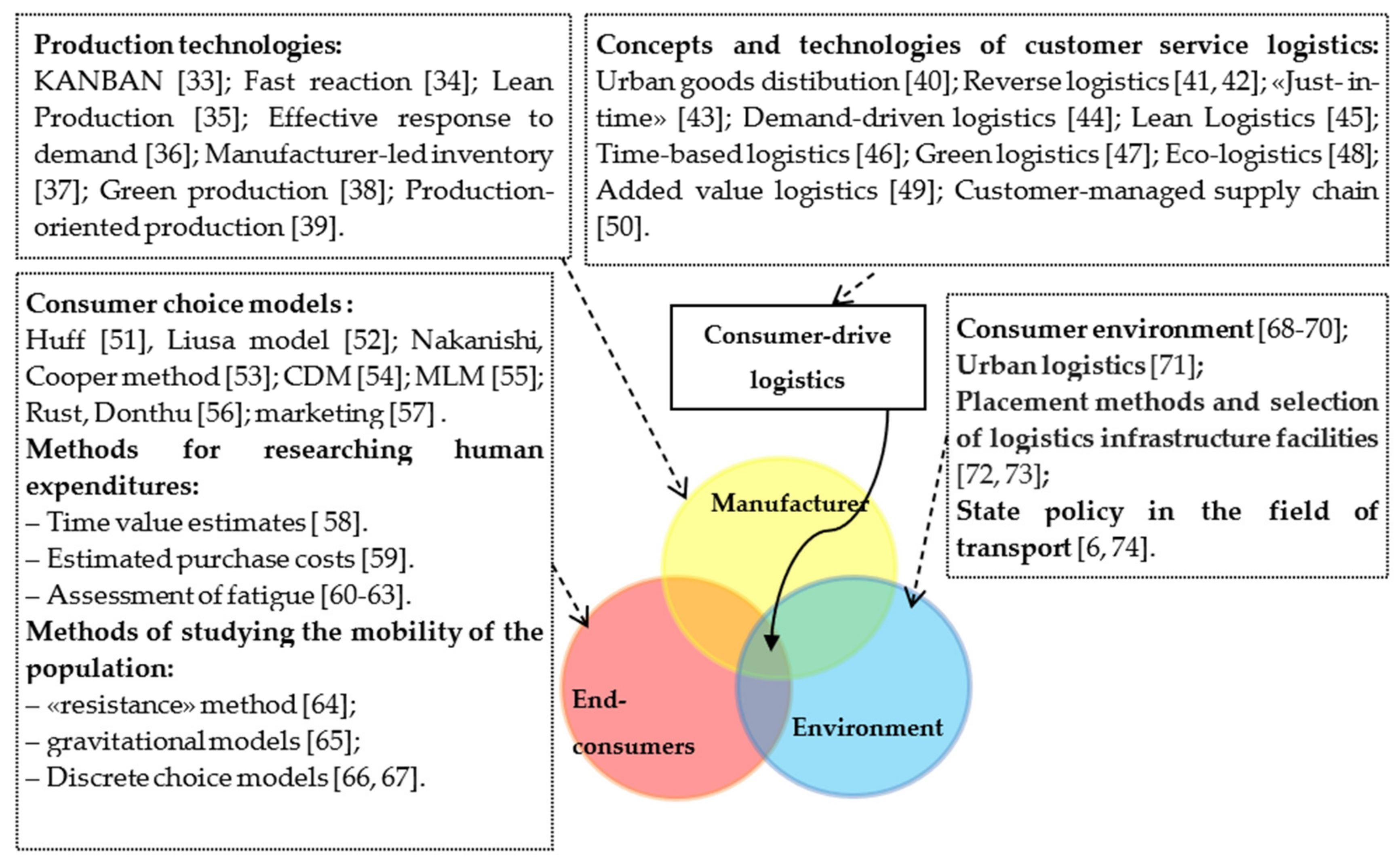
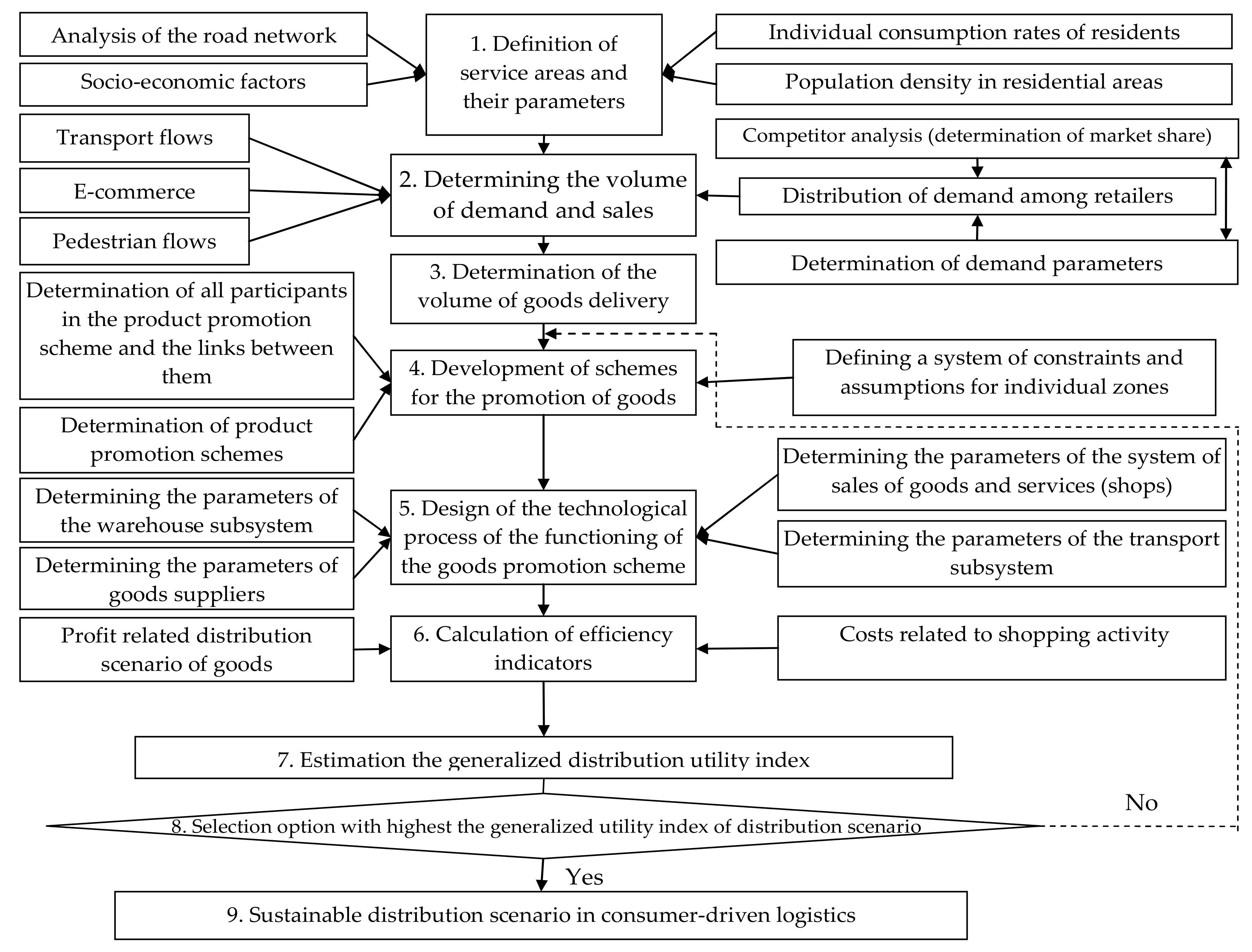
 —retailer;
—retailer;  —material flow;
—material flow;  —end-consumers flow;
—end-consumers flow;  —goods flow; —quantity of m-th freight flow в material flow v-th participant k-th supplying scenario of goods, t; —probability of demand for goods of the j-th retailer by residents of the ω-th district of the z-th service zone; KC—end-consumers; —volume of goods at the link «member of the retail network—household», t.
—goods flow; —quantity of m-th freight flow в material flow v-th participant k-th supplying scenario of goods, t; —probability of demand for goods of the j-th retailer by residents of the ω-th district of the z-th service zone; KC—end-consumers; —volume of goods at the link «member of the retail network—household», t.
 —retailer;
—retailer;  —material flow;
—material flow;  —end-consumers flow;
—end-consumers flow;  —goods flow; —quantity of m-th freight flow в material flow v-th participant k-th supplying scenario of goods, t; —probability of demand for goods of the j-th retailer by residents of the ω-th district of the z-th service zone; KC—end-consumers; —volume of goods at the link «member of the retail network—household», t.
—goods flow; —quantity of m-th freight flow в material flow v-th participant k-th supplying scenario of goods, t; —probability of demand for goods of the j-th retailer by residents of the ω-th district of the z-th service zone; KC—end-consumers; —volume of goods at the link «member of the retail network—household», t.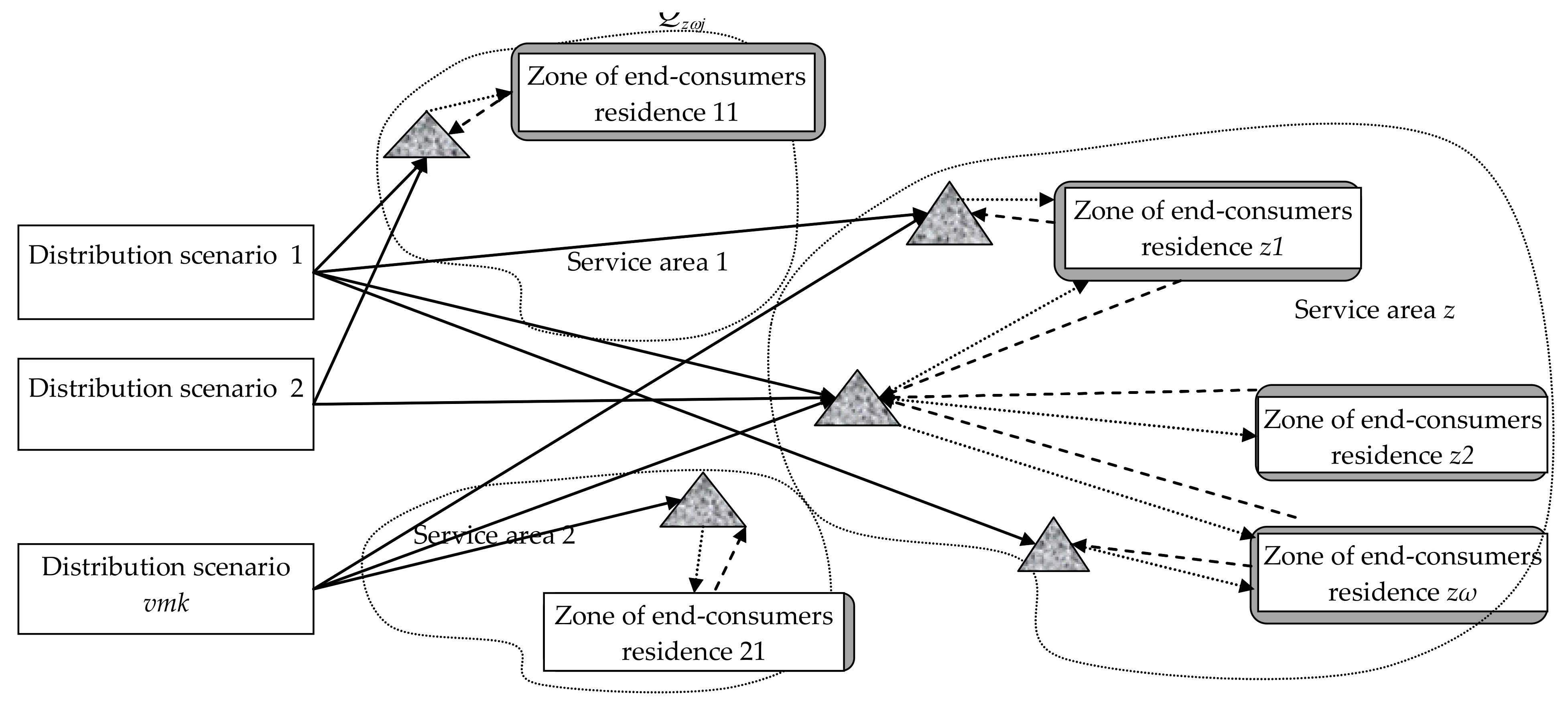



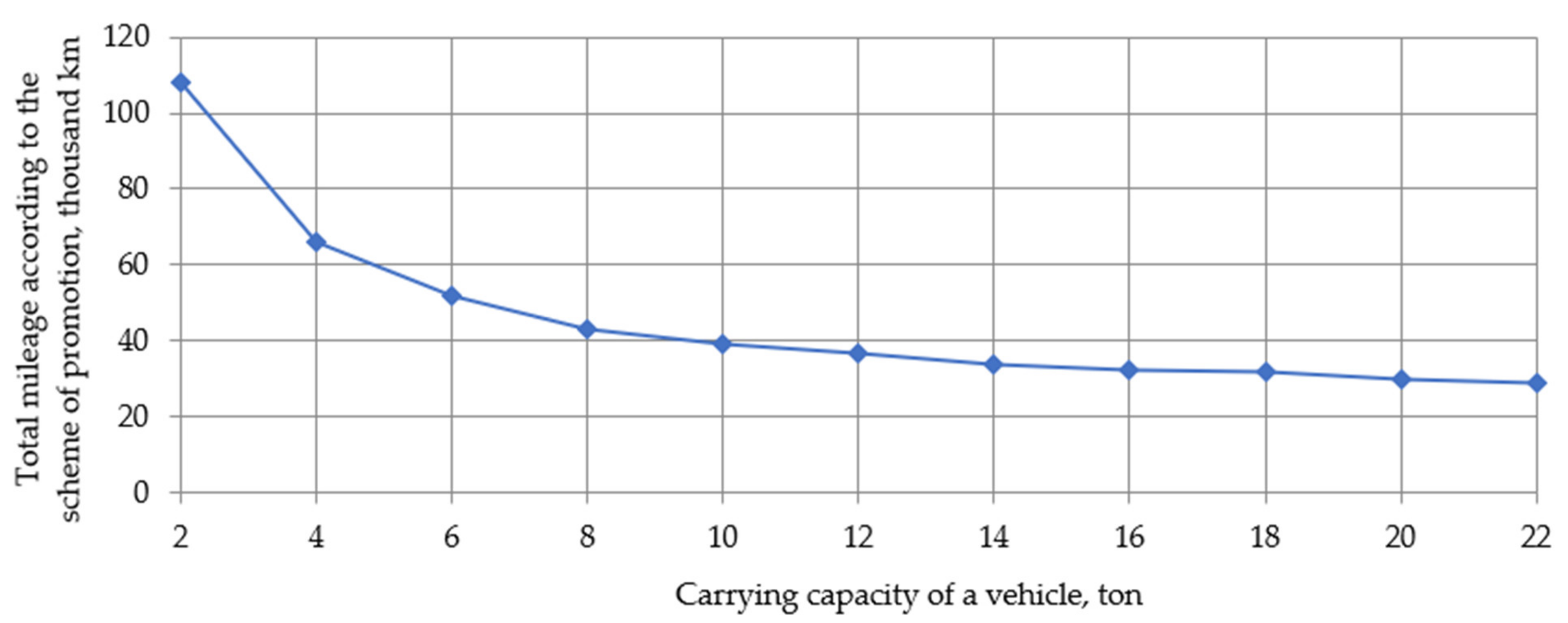
 —freight flow according to the scenario of goods distribution, thousand 12 tons;
—freight flow according to the scenario of goods distribution, thousand 12 tons;  —cost of freight flow, UAH/kg;
—cost of freight flow, UAH/kg;  —expedient load capacity of vehicles, t.
—expedient load capacity of vehicles, t.
 —freight flow according to the scenario of goods distribution, thousand 12 tons;
—freight flow according to the scenario of goods distribution, thousand 12 tons;  —cost of freight flow, UAH/kg;
—cost of freight flow, UAH/kg;  —expedient load capacity of vehicles, t.
—expedient load capacity of vehicles, t.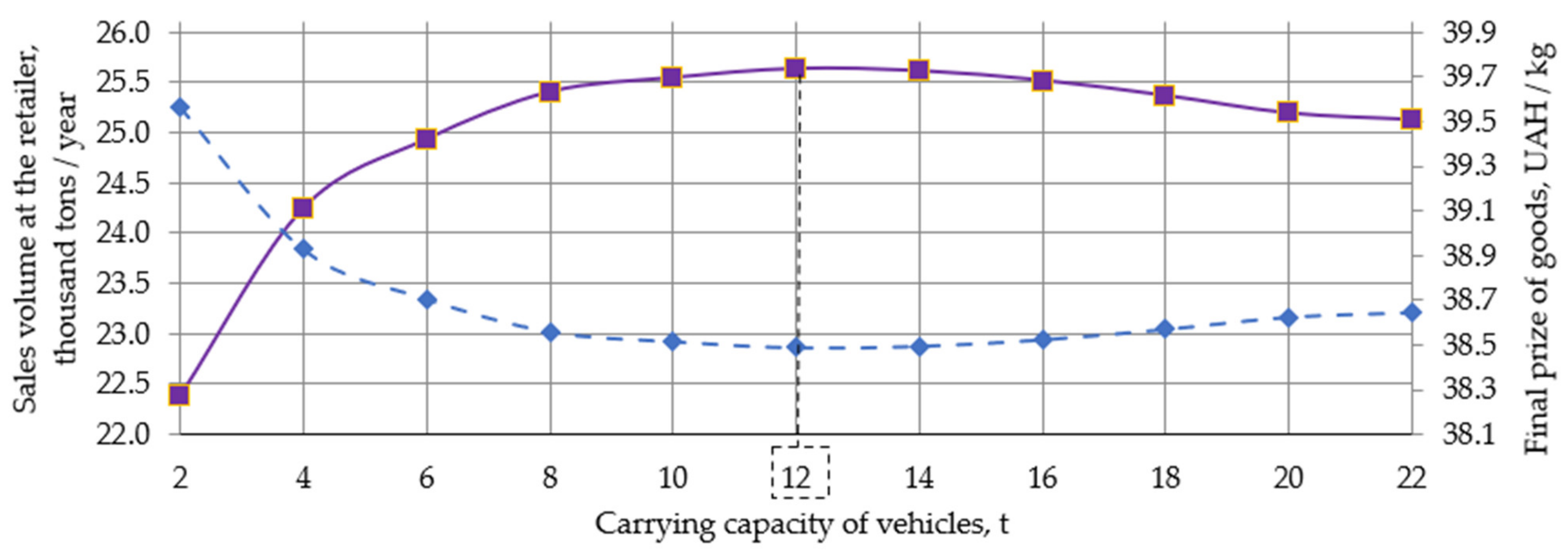
 —sales volume under the distribution scenario, thousand tons;
—sales volume under the distribution scenario, thousand tons;  —average distance covered by end-consumers to the retail network, km;
—average distance covered by end-consumers to the retail network, km;  —expedient load capacity of vehicles, ton.
—expedient load capacity of vehicles, ton.
 —sales volume under the distribution scenario, thousand tons;
—sales volume under the distribution scenario, thousand tons;  —average distance covered by end-consumers to the retail network, km;
—average distance covered by end-consumers to the retail network, km;  —expedient load capacity of vehicles, ton.
—expedient load capacity of vehicles, ton.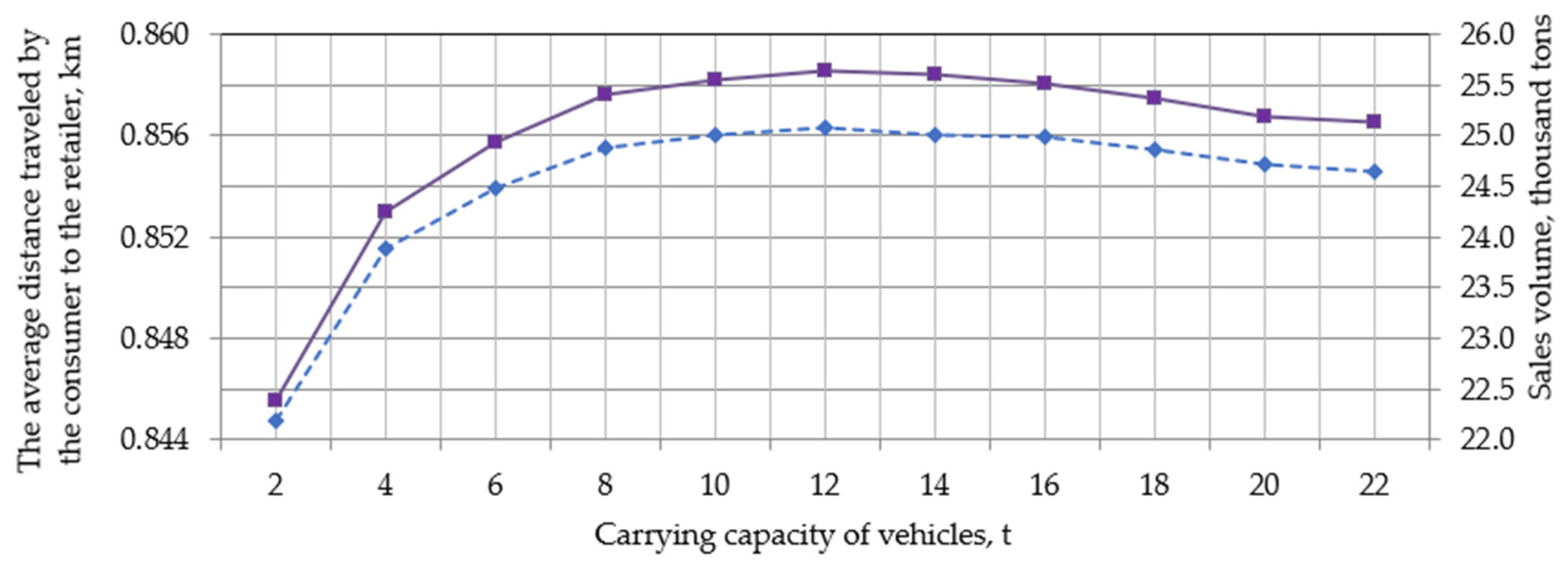
 —freight flow according to the distribution scheme, thousand tons;
—freight flow according to the distribution scheme, thousand tons;  —cost expression of the amount of energy consumed due to the activity of acquisition, UAH.
—cost expression of the amount of energy consumed due to the activity of acquisition, UAH.
 —freight flow according to the distribution scheme, thousand tons;
—freight flow according to the distribution scheme, thousand tons;  —cost expression of the amount of energy consumed due to the activity of acquisition, UAH.
—cost expression of the amount of energy consumed due to the activity of acquisition, UAH.
 —volume of goods under the distribution scenario, t;
—volume of goods under the distribution scenario, t;  —cost expression of time consumed due to the activity of acquisition, UAH.
—cost expression of time consumed due to the activity of acquisition, UAH.
 —volume of goods under the distribution scenario, t;
—volume of goods under the distribution scenario, t;  —cost expression of time consumed due to the activity of acquisition, UAH.
—cost expression of time consumed due to the activity of acquisition, UAH.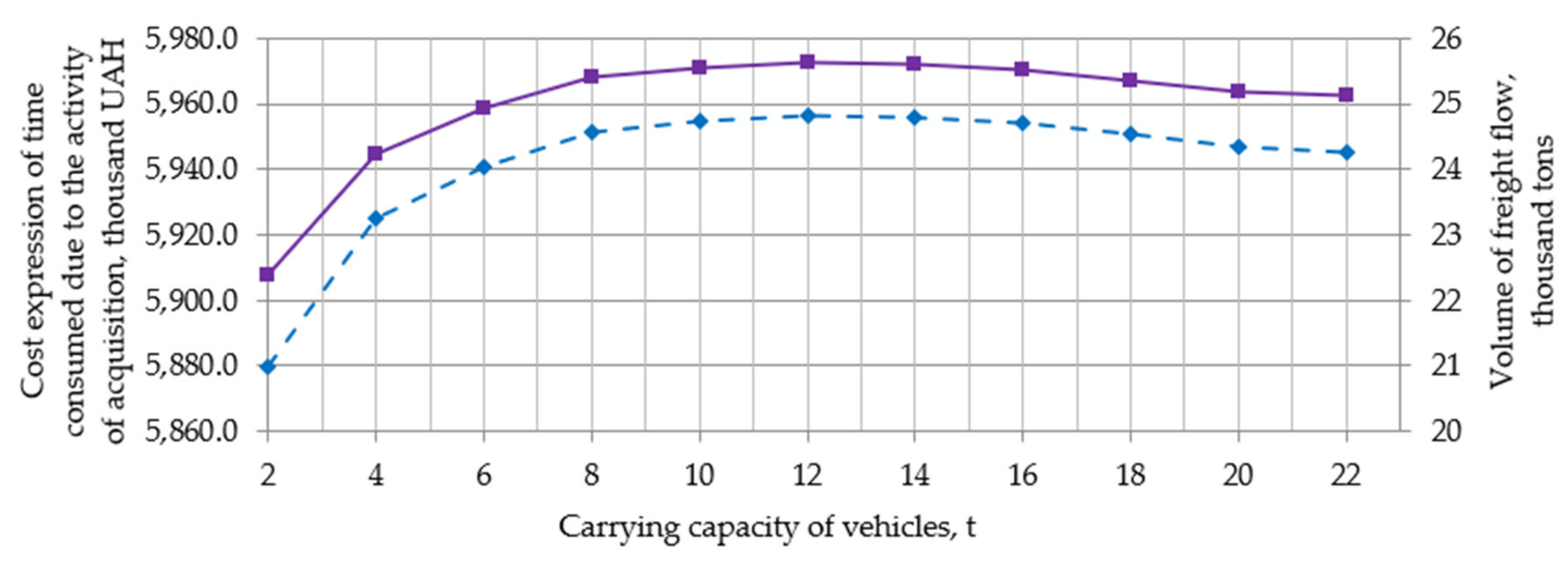

 —the generalized distribution utility index in consumer-driven logistics scenario, UAH;
—the generalized distribution utility index in consumer-driven logistics scenario, UAH;  —selling volume via supply scenario, thousand ton.;
—selling volume via supply scenario, thousand ton.;  —profit of supplying scenario, UAH.
—profit of supplying scenario, UAH.
 —the generalized distribution utility index in consumer-driven logistics scenario, UAH;
—the generalized distribution utility index in consumer-driven logistics scenario, UAH;  —selling volume via supply scenario, thousand ton.;
—selling volume via supply scenario, thousand ton.;  —profit of supplying scenario, UAH.
—profit of supplying scenario, UAH.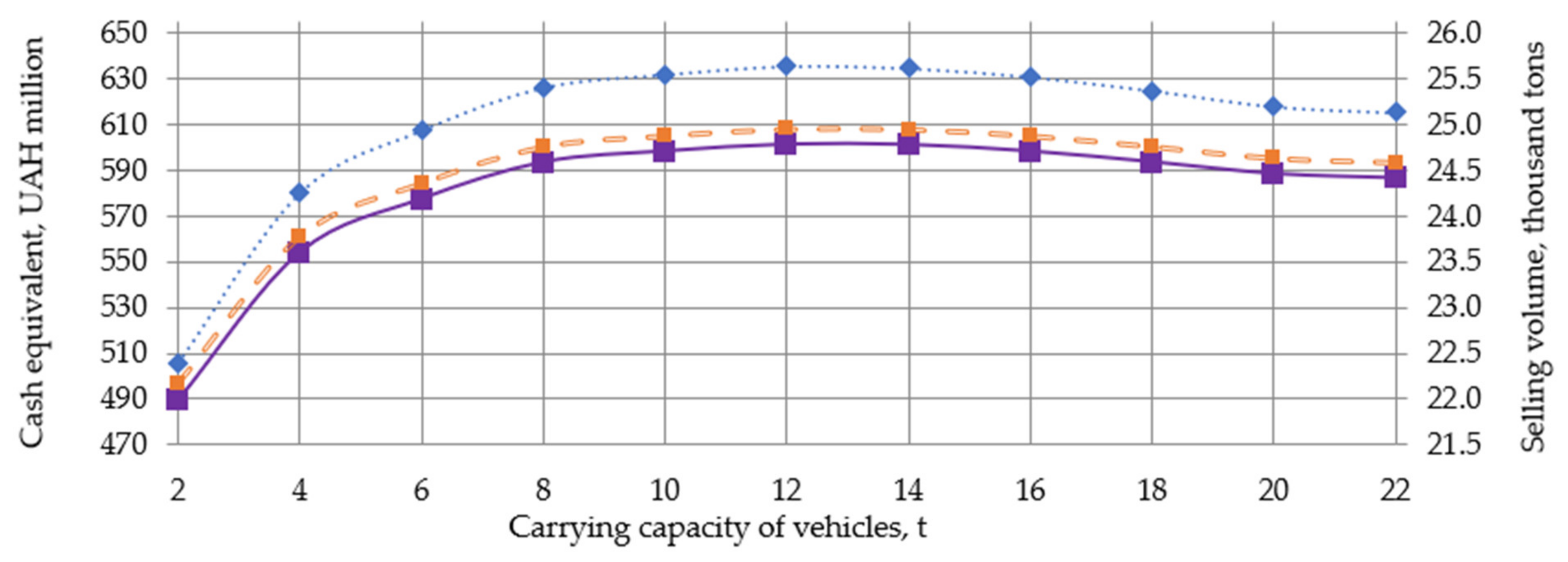
Publisher’s Note: MDPI stays neutral with regard to jurisdictional claims in published maps and institutional affiliations. |
© 2022 by the authors. Licensee MDPI, Basel, Switzerland. This article is an open access article distributed under the terms and conditions of the Creative Commons Attribution (CC BY) license (https://creativecommons.org/licenses/by/4.0/).
Share and Cite
Galkin, A.; Schlosser, T.; Khvesyk, Y.; Kuzkin, O.; Klapkiv, Y.; Balint, G. Development of Generalized Distribution Utility Index in Consumer-Driven Logistics. Energies 2022, 15, 872. https://doi.org/10.3390/en15030872
Galkin A, Schlosser T, Khvesyk Y, Kuzkin O, Klapkiv Y, Balint G. Development of Generalized Distribution Utility Index in Consumer-Driven Logistics. Energies. 2022; 15(3):872. https://doi.org/10.3390/en15030872
Chicago/Turabian StyleGalkin, Andrii, Tibor Schlosser, Yuliia Khvesyk, Olexiy Kuzkin, Yuriy Klapkiv, and Gabriel Balint. 2022. "Development of Generalized Distribution Utility Index in Consumer-Driven Logistics" Energies 15, no. 3: 872. https://doi.org/10.3390/en15030872
APA StyleGalkin, A., Schlosser, T., Khvesyk, Y., Kuzkin, O., Klapkiv, Y., & Balint, G. (2022). Development of Generalized Distribution Utility Index in Consumer-Driven Logistics. Energies, 15(3), 872. https://doi.org/10.3390/en15030872








